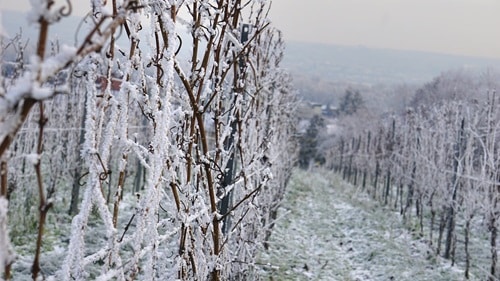
What is a spring frost?
Spring frost is a climatic phenomenon dreaded by winegrowers, as it can cause serious damage to vines, especially those in the growth stage. Spring frosts occur when temperatures drop drastically during the nights of spring, and the water in the buds and young shoots of plants freezes, causing what are known as spring frosts.
After winter, temperatures start to warm up and buds begin to open, marking the start of the vine’s growth cycle.
If a drop in temperature occurs at this time, the young buds, which are highly sensitive to cold, can be damaged, compromising future harvests.
Spring frost can wipe out a large part of a vineyard’s production, so growers need to be particularly vigilant and use a variety of methods to protect their vines, such as wind towers.
Types of gel
Winegrowers have to cope with different types of frost that can affect their vines, particularly during the spring when buds are more vulnerable.
White gel or radiation gel
This type of frost is named after the layer of white frost that covers the vines and buds. It can occur at the end of the night, just before sunrise, when a number of climatic conditions come together:
- Clear skies: the white frost of spring occurs at night when the sky is clear of clouds. Clouds act as a blanket, retaining the heat accumulated by the ground during the day; without them, the temperature falls more rapidly.
- Little or no wind: light wind favors the accumulation of cold air, which is denser near the ground. A stronger wind would disperse this cold air, reducing the risk of frost on the ground and on plants.
- Moisture: frost forms with moisture. When moisture condenses, it can freeze on cold surfaces, creating a layer of frost.

Damage caused by frost can be limited if conditions are not too severe and if the frost lasts only a short time. However, even a short period of frost can cause significant damage to vine buds that are in the active development phase, as they are very sensitive to low temperatures.

Black gel or advective gel
Unlike white frost, black frost does not involve the formation of frost. This type of frost is often associated with windy conditions and severe overnight cooling.
Black frost is characterized by the arrival of cold air masses that reduce the ambient air temperature to well below 0°C.
Black frost can occur at any time during the night or even during the day if the conditions are right:
- Cold air invasion: a black frost occurs when cold air masses are present.
- Strong wind: unlike white frost, black frost is accompanied by wind. The wind carries cold air through the vineyard, preventing warmer air from settling near the ground, thus cooling the plants.
- Cloud cover: the sky can be cloudy or clear.
- Prolonged weather: black frost can last longer than white frost, often several hours after sunrise and sometimes during the day if temperatures remain low.
Black frost is more destructive than white frost because it is not limited to the surface of plant tissue. It can penetrate deeper into plants.
The consequences of spring frost
Spring frost is a climatic event dreaded by winegrowers, as it can be detrimental to vines that are emerging from their winter dormancy and are more sensitive to cold.
A sudden drop in night-time temperatures below freezing can cause water inside buds to freeze, resulting in cell damage that compromises their viability and development.

The consequences of spring frosts are varied:
- Yield reduction: bud damage can reduce the amount of fruit produced by the vine, lowering yields.
- Delayed growth: vines affected by frost may experience delayed growth, as the plant must either repair the damage or develop new buds.
- Economic loss: for winegrowers, the financial consequences can be considerable. Loss of harvest due to frost leads directly to loss of income.
Techniques to combat spring frosts
Technique 1 - Spraying vines with water
Spraying vines with water overnight can help prevent frost damage and protect them from the cold. As the water freezes, it releases heat, which can keep bud temperatures above freezing. This method is effective as long as sprinkling is maintained for the duration of the frost.
Technique 2 - Ventilation
The use of wind towers can help mix cold air layers near the ground with warmer air at higher altitudes, thus reducing the risk of frost in the vines.
Technique 3 - Heating
A technique that involves placing heaters such as candles or oil burners between the rows of vines. This generates enough heat to raise the temperature around the plants and vines, thus reducing the risk of frost.
Technique 4 - Winter sails
Covering vines with wintering sails or canopies can help retain soil heat overnight and protect buds from the cold. Overwintering sails work like a layer of insulation, trapping warm air from the soil as it rises and preventing cold outside air from reaching the plants directly. However, wintering sails cannot be used in AOCs, as they modify the terroir and local climate.

